PSA: Small white dogs are not just cute and fluffy! They also have remarkable personalities and aptitudes, which make them awesome pets.
Below, we’ll share a collection of different small white dog breeds, each with their own unique quirks and rich ancestry — from Spanish sailor dogs to royal companions, there may be a dog on this list that’s the best fit for your family.
Let’s check ’em out!
17 Small White Dog Breeds
There’s a huge variety of small white dog breeds, and while they may feature similar physical characteristics, they all have their unique personalities and features that make them special.
So, whether you are looking to own a small white dog, or would just like to know a bit more about them, we’ve got you covered! Here come 17 tiny white pooches!
1. Bichon Frise
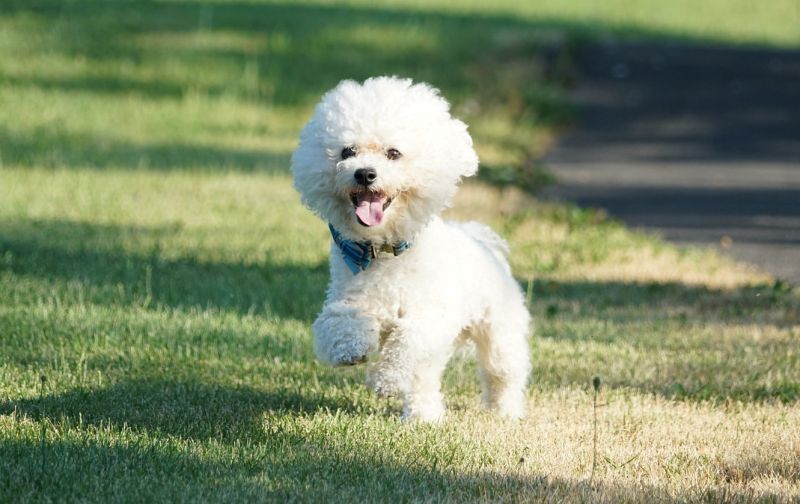
Four of the small white dog breeds we’re sharing today fall under the Barbichon group that originated from the Mediterranean: the bichon frise, the bichon Maltese, the bichon Bolognese and the bichon Havanese (“bichon” is a Middle French word meaning small, long-haired dog).
The bichon frise originates from Tenerife in the Canary Islands, and were such popular companions of Spanish sailors that they were originally known as Bichon Tenerife in the 1300s.
The bichon frise (along with bichon frise mixes) is a small breed, their average weight being around 12 to 18 pounds. They’re instantly recognizable by their fluffy white fur and friendly faces. Daily grooming (and a good food) is required to keep their cloud-like coats looking and feeling their best, so many bichon owners take their pet to the groomers every 4 to 6 weeks.
As confident little creatures, bichon frises get on well with children and other dogs. Their size makes them the ideal inner city companion, though they require a good amount of exercise so access to a safe park or outdoor space is a must. This breed performs particularly well in agility competitions, which provides fantastic mental and physical stimulation for them!
2. Maltese
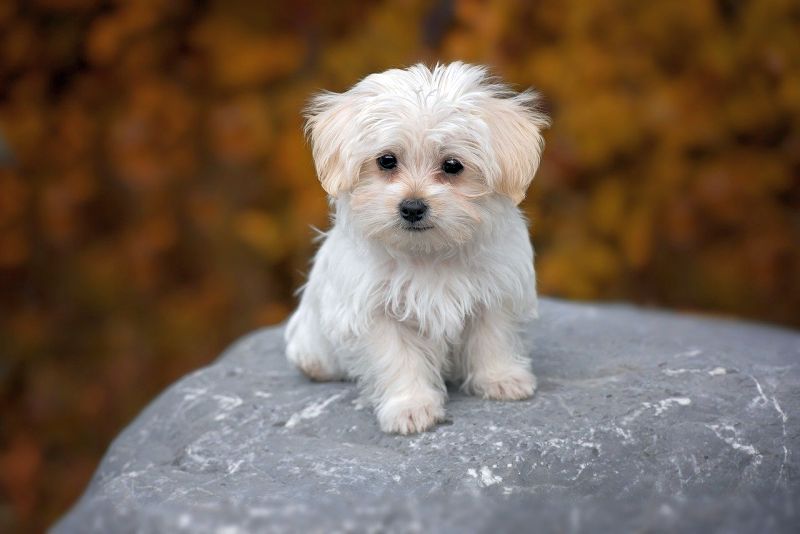
The second member of the Barbichon family is the Maltese, from (you guessed it) Malta. Often sporting a bow in their signature long white locks, these elegant creatures require regular baths and daily grooming to keep them looking their aristocratic best.
As well as consistent grooming, Maltese and Maltese mix breed owners will also need to remain consistent with their obedience training. This is important as these lap dogs are incredibly quick at identifying ways of getting what they want from their owner.
Maltese are a cuddly breed and make great companion animals who only require occasional exercise. So, they’re a great choice for those with mobility issues or living in city environments. If you’re on the way to buying a Maltese puppy, the AKC recommends getting them bile-acid tested to rule out congenital liver issues such as liver shunts.
3. Bolognese
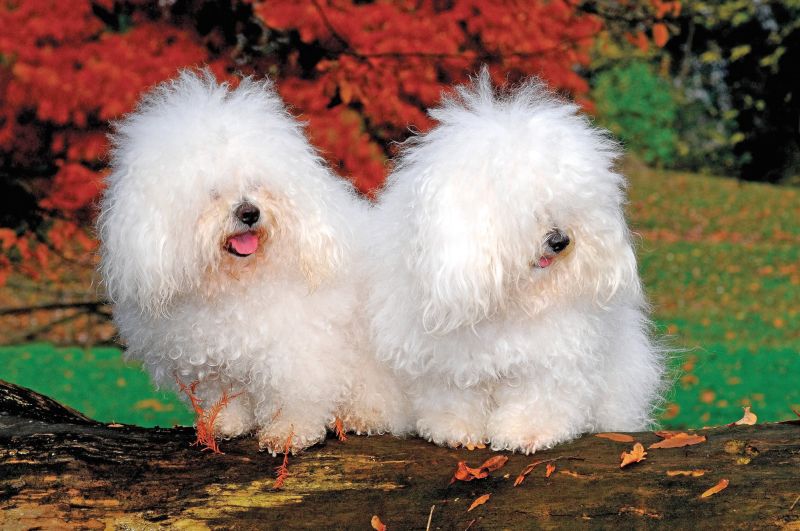
The Bolognese (also known as the Bichon Bolognese) is the Italian member of the Barbichon group, developed centuries ago in the city of Bologna. They are a small, stocky breed, with a long white curly-hair coat.
Due to their calm, loyal nature and moderate exercise requirements, they make fantastic dog breeds for older seniors or those who are retired. But note that the Bolognese can be prone to separation anxiety, and they will need to be around their owners a lot.
The Bolo (as the breed is sometimes called) is one of the lowest maintenance small white dogs around, as their grooming needs are similar to those that most dogs require — nail clips, weekly baths, and regular brushing — you know the deal!
4. Havanese

The final member of the Barbichon group is the Havanese. Named after the capital of Cuba, Havanese are small and sturdy, with long silky coats and curly tails. They’re cheeky, charming, and bound to add joy to any household!
Like most small breeds, the Havanese’s exercise requirements don’t extend further than a daily walk or play in the backyard. They also really enjoy agility training which can be a great outlet for physical energy and a lovely way to bond with your Havanese.
They are gentle pups, who can be sensitive (as are most Havanese mixes). So, when training these doggos, you’ll want to remain patient and avoid scolding them. They also thrive best in single-dog homes, as they won’t do well living with feistier, more vocal breeds.
Already have one of these floofs? Be sure you’re feeding her a good dog food for Havanese.
5. Pomeranian

Pomeranians are an energetic addition to the toy breeds. But don’t let their size fool you, those tiny bodies contain some huge personalities!
The Pom’s popularity has noble origins, as Queen Victoria was largely responsible for bringing them into the mainstream and frequently exhibited them at the Crufts dog show. Marie Antoinette and Wolfgang Amadeus Mozart were also lovers of the Pomeranian.
You could say that the Pomeranian’s high status beginnings have meant they have become accustomed to a certain lifestyle — the breed is a bona fide lapdog and needs a significant amount of grooming, with particular attention paid to their coats and teeth.
Pomeranians and Pomeranian mixes are very intelligent and respond well to training, so much so that they are often used as therapy dogs. Their small size makes them notorious escape artists, so recall training (and an escape-proof harness) is recommended. Poms can also be prone to bone and joint issues, so they must be trained to not jump off of beds or couches.
6. Toy Poodle
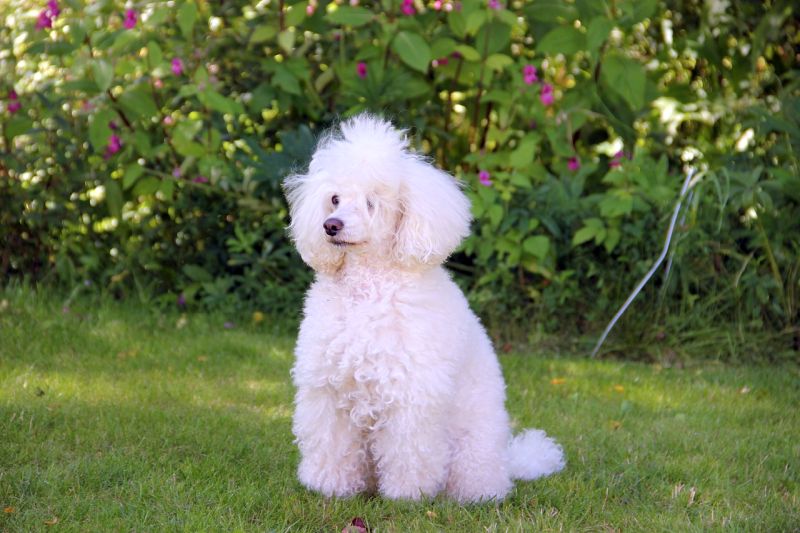
Toy poodles, as the name suggests, are smaller type of poodle as opposed to the standard version. They possess all the wonderful qualities of their “standard” counterpart, just in miniature!
The perky poodle has a reputation for being flamboyant, but the breed originated as duck hunters in Germany and were known as “pudelin”, which means “splashing in water.” Toy poodles are awesome companions regardless, but especially if you also love to swim or live near water!
Their famous curly coats are designed to protect them against cold water, so your poodle may still like to swim well into the fall or earlier in the spring than you’d think! Those curls will need to be brushed daily to avoid matting, and they must be clipped or trimmed every four to six weeks.
Toy poodles are not only a highly energetic breed but also highly intelligent, so they will need an owner who can accommodate the mental and physical stimulation they need. Poodles are natural-born retrievers so they’ll always love a good ol’ game of fetch. You could also try enrichment games that play to their hunting instincts.
7. American Eskimo
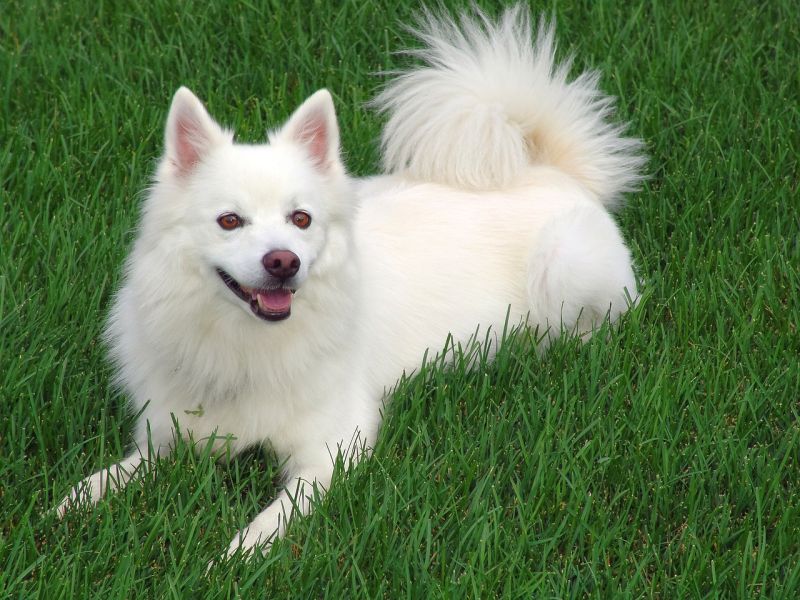
The American Eskimo is, well… “It’s so fluffy I’m gunna die!” Their thick white (ever so fluffy) lion-like mane and prick ears are key clues that they belong in the Nordic spitz family. You’ll find them in three different sizes, with the smallest weighing only around 6 pounds!
American Eskimo dogs have slightly misleading names, as Eskimos (or Inuit, as they’re more commonly called now) had nothing to do with the origin of the breed. Instead, they are likely to have evolved from the German spitz breed. Their adorable, fun-loving energy led them to circus work in the 19th century, where an American Eskimo dog was the first ever canine to walk a tightrope!
Eskies are very clever creatures, so they need lots of mental stimulation or will resort to creating their own (a polite way of saying they may become destructive). In addition to lots of obedience training and access to toys, fun dog games will help keep your American Eskimo dog entertained.
These perky pups don’t like to spend a whole lot of time outdoors but still require a moderate amount of exercise, so they’re great for small apartment city dwellers. Their playful, eager to please nature means they’re also a small breed that’s great with kids.
8. French Bulldog
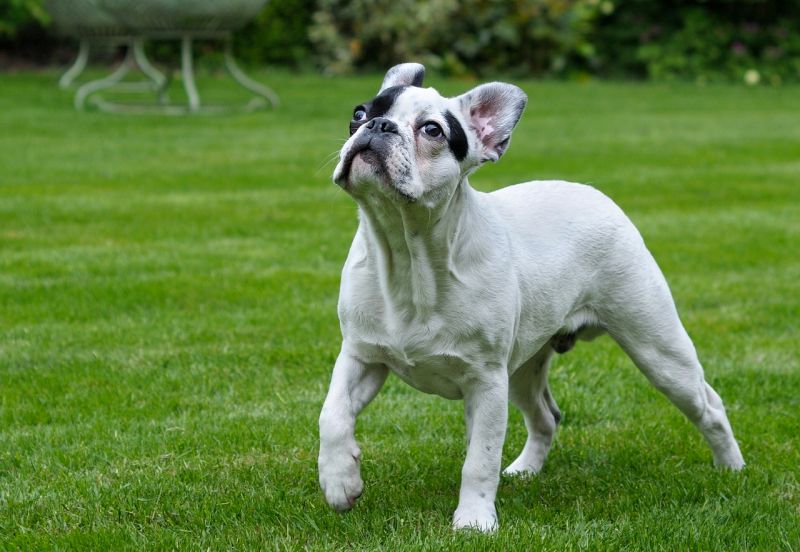
Coined one of the best dogs for city living, the French bulldog is an incredibly popular breed due to their charming, playful dispositions and cute bat-shaped ears. They also have big personalities that will help them to thrive in most families and households.
Despite their muscular frames, Frenchies and French bulldog mixes only require a short walk a day to satisfy their exercise requirements. And, as a flat faced breed, they shouldn’t be allowed to overexert themselves in hot weather. French bulldogs can’t swim well, so if you own a pool or live near a body of water, extra caution is required.
The Frenchies’ fur rarely sheds and requires minimal grooming due to its short length. Instead, their grooming focus will need to be on the unique folds of their face, ensuring they are kept clean and dry.
9. Coton de Tulear
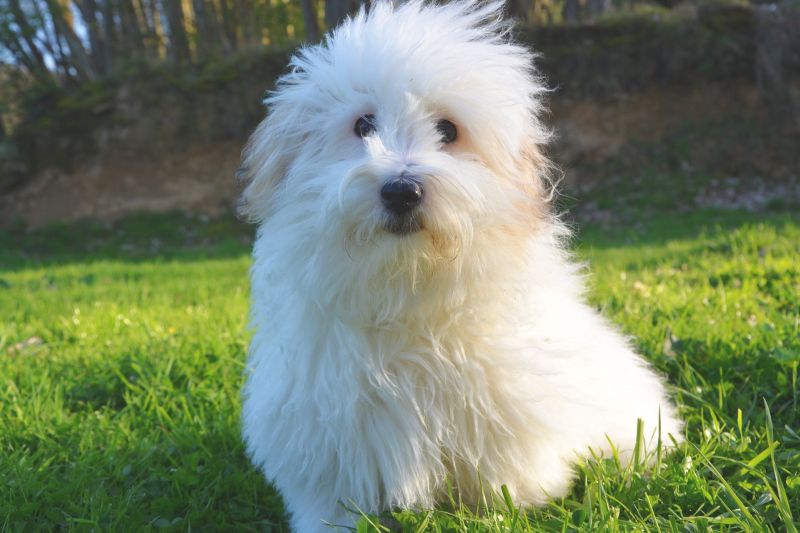
If you’re a fan of fluffy dogs and want a small white breed, you need a coton de Tulear in your life! The “coton” in their name is French for “cotton,” referring to their cloud-like white coats, and “Tulear” is a seaport town in Madagascar, where they were the royal’s favorite breed.
The coton de Tulear has an amazing life expectancy of 15 to 19 years, and the breed suffers from very few genetic diseases. That being said, any responsible coton de Tulear breeder will still carry out the standard health tests on their dogs prior to breeding them.
10. Puli
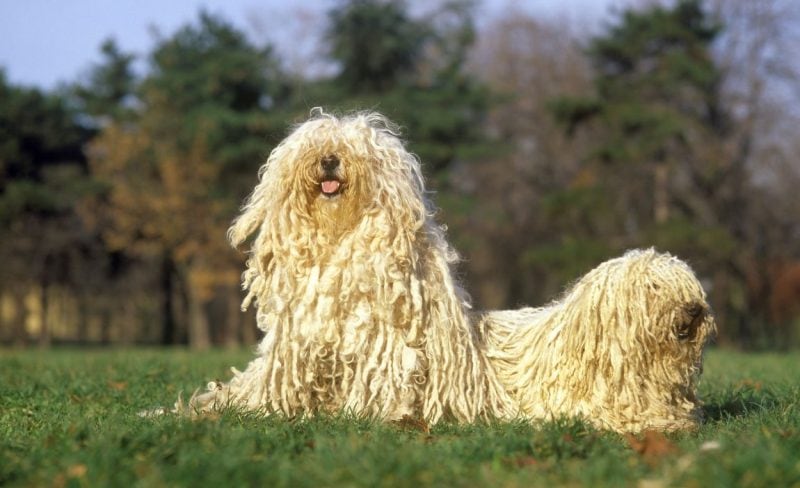
One of the bigger small white dog breeds we’ll talk about today, the puli is a distinctive looking breed thanks to his long low shedding fur that looks like cords or locs. They tend to weigh around 25 to 35 pounds once they are fully grown.
A puli’s grooming regimen is one that’ll certainly take a bit of time and practice, especially in the early stages of your pup’s life when these cords start to form. There are a ton of great resources out there to help you master the technique, so don’t let that stand in your way if you like the breed.
Pulis were originally bred as herding dogs. Accordingly, they are super smart and have a lot of energy, so physical and mental stimulation (as well as a high-quality dog food) are very important. While loyal and eager to please, they are headstrong, so you’ll need lots of patience training them.
11. Chinese Crested
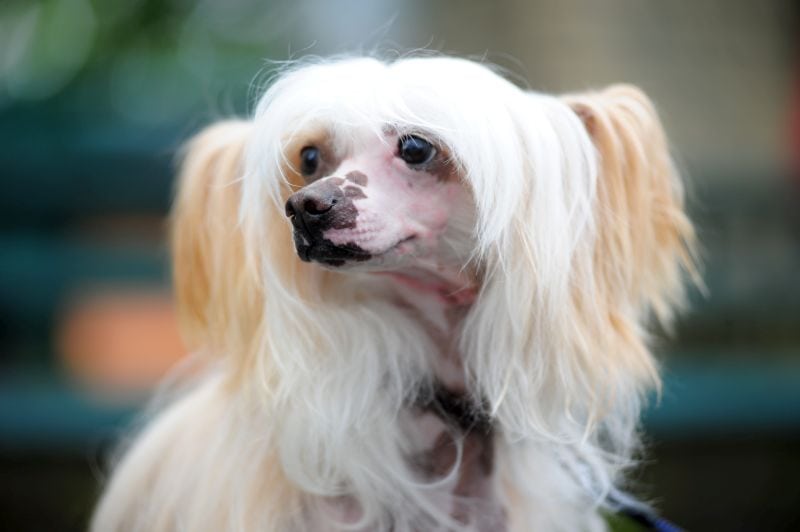
A breed unlike any other, the Chinese crested is famous for his unique hairdo and hairless body. There’s also a version of the breed that has a full body of fur, known as the “powerpuff” variety. This elegant Chinese dog breed stands at around 13 inches tall and is considered one of the best dogs for kids.
The Chinese crested breed has a rich history dating back to ancient times, where hairless dogs were first brought to China from Africa on trading vessels. They gained an excellent reputation aboard these ships for catching rats and other vermin, so don’t be surprised if your Chinese crested starts exhibiting hunting behavior!
If you’re planning on owning a hairless Chinese crested, you’ll need to fit him with protective clothing or sunscreen when out in the sun on his daily walk. If you wanna mix things up, Chinese cresteds are awesome at lure coursing and they love to do it!
Check out some of the best dog foods for Chinese crested dogs!
12. Miniature Bull Terrier
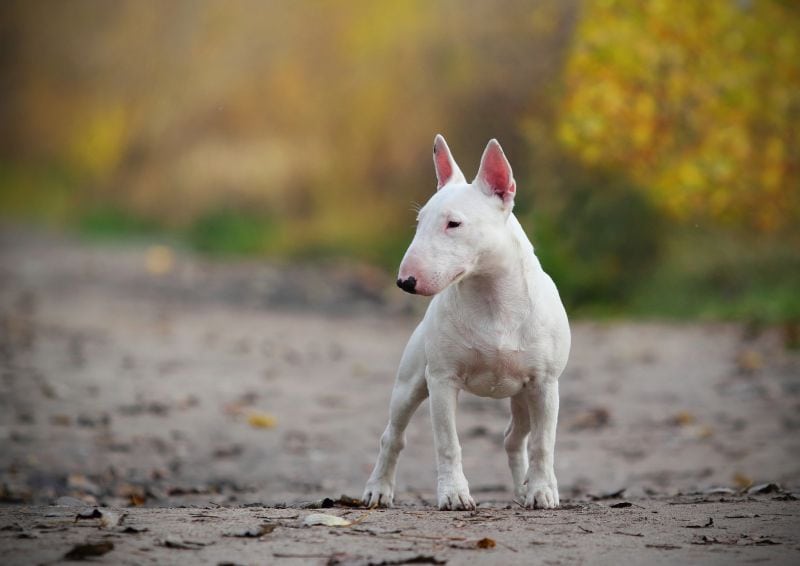
If you’re familiar with the bull terrier, the miniature version will need no introduction. For reference, the bull terrier stands at around 22 inches tall, while the miniature bull terrier is normally only 14 inches tall.
These guys are affectionately known as the “class clown” of dog breeds, as they are such funny, mischievous personalities. This can often tip over into misbehavior, and some owners report that they are notorious for eating things they shouldn’t! But obedience training in a positive, fun manner should ensure their personalities remain all of the nice and not so much of the naughty!
While grooming a miniature bull terrier is a breeze, exercising them can be a tad tricky. As puppies they can be prone to sudden lameness due to rapid muscle density and growth, which can put pressure on their joints. Therefore, as an owner of a miniature bull terrier puppy your key responsibilities will be ensuring exercise is kept to a minimum and that your pooch doesn’t jump up or down from heights — we see you sofa dawgs!
13. Japanese Spitz
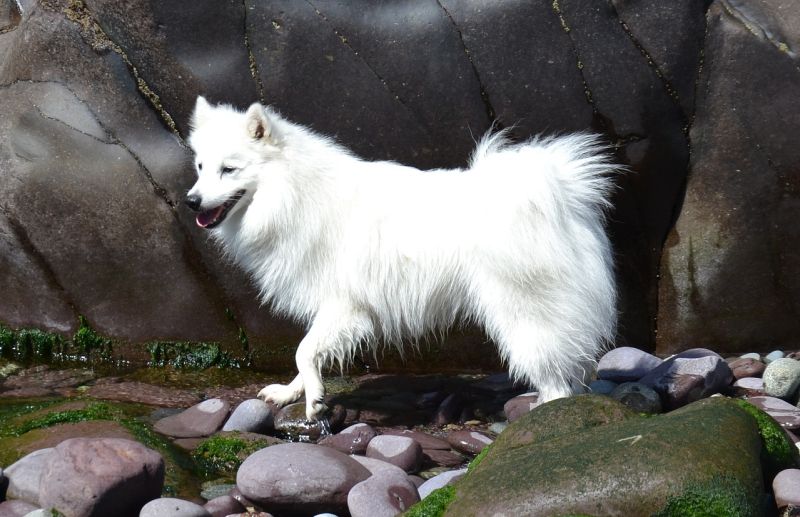
The Japanese spitz has fluffy white fur, a fox-like pointed muzzle, and a cute button black nose and pair of eyes — it’s like Walt Disney drew them up himself! Their size is considered “miniature,” and they are not dissimilar in build to our American Eskimo friends.
Sadly, the Japanese spitz’s full history was destroyed during WWII so what we know is limited. However, there is recorded proof of their first exhibition in Tokyo in 1921, and they became an official Japan Kennel Club breed in 1948.
A truly adaptable breed, the Japanese spitz will thrive in any environment. While these dogs prefer warmer climates, they are adventurous creatures that’ll love running ‘round ranches as much as a weekend at the lake. They love their humans and are commonly known as comedians due to their eager-to-please, funny character.
If fur shedding bothers you, this isn’t this Japanese dog breed for you. They shed a lot (and we mean a lot) of their undercoat twice a year, a process that takes around two or three weeks. Owners have reported that it truly gets everywhere — clothing, carpet, furniture, you name it! Otherwise their grooming requirements are pretty minimal.
14. Chihuahua
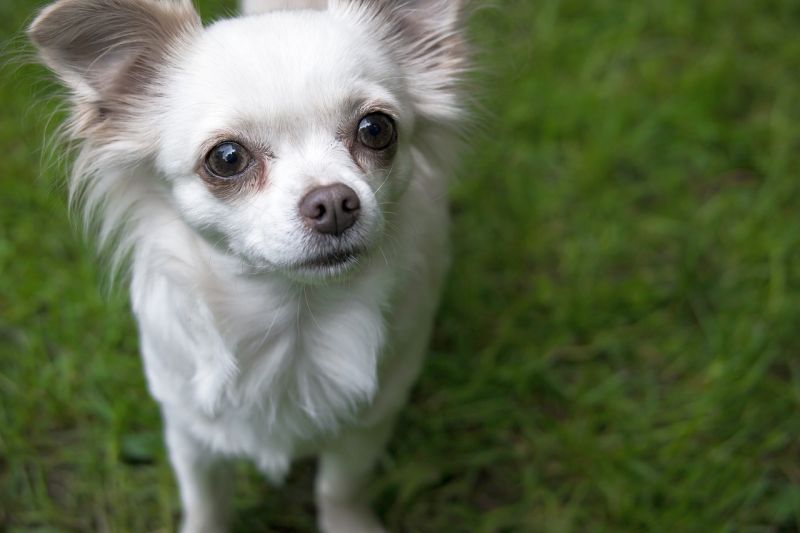
You’ve probably seen a Chihuahua in the arms of Hollywood’s socialites, or stealing the show as Bruiser Woods in Legally Blonde — these dogs are famous for their tiny bodies and huge personalities. And they’re ideal companions for all cities, not just Beverly Hills!
Owners report that as playful pups, Chihuahuas and Chihuahua mixes get ample exercise from being around the house, however, a short daily walk where they get to experience new sights and sniffs is always good for their mental and physical wellbeing.
Chihuahuas have been known to have a commanding temperament, so a firm (but always positive) hand is needed when obedience training, especially when reinforcing that you are in charge, not them!
As with all breeds, Chihuahuas are predisposed to genetic diseases, which should be ruled out by a responsible breeder. Otherwise, they are very healthy creatures — so much so, a 2001 study discovered that Chihuahuas were found to have the lowest cases of periodontal disease out of all the dog breeds studied!
15. West Highland White Terrier
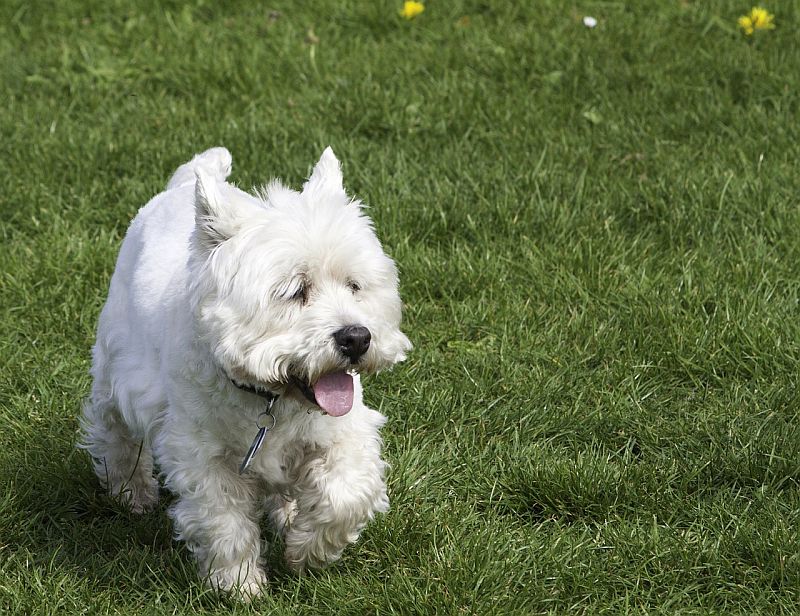
The final three additions to our list require a brief visit across the pond — first stop, Scotland! The West Highland terrier is a confident, independent, and faithful breed that has been established for well over 300 years. Typical terriers, they’re plucky, fearless, and completely charming.
A number of wonderful terrier breeds come from Scotland, including the West Highland. Their journey began as rodent hunters (also known as ratter dogs), but they quickly became wonderful family members across the UK and other parts of the world.
Westies are very low maintenance and only require your standard canine grooming routine. Their training routine however, will require a little more work. As they were bred to work alone, their independence can be a challenge when teaching them to respond to commands. Keeping things fun and entertaining is the key!
They love being outdoors and are an active breed, but Westies also instinctively love to chase things, so recall and leash training are imperative if you’re planning lots of outdoor adventures where there could be animals about, like squirrels.
16. Parson Russell Terrier
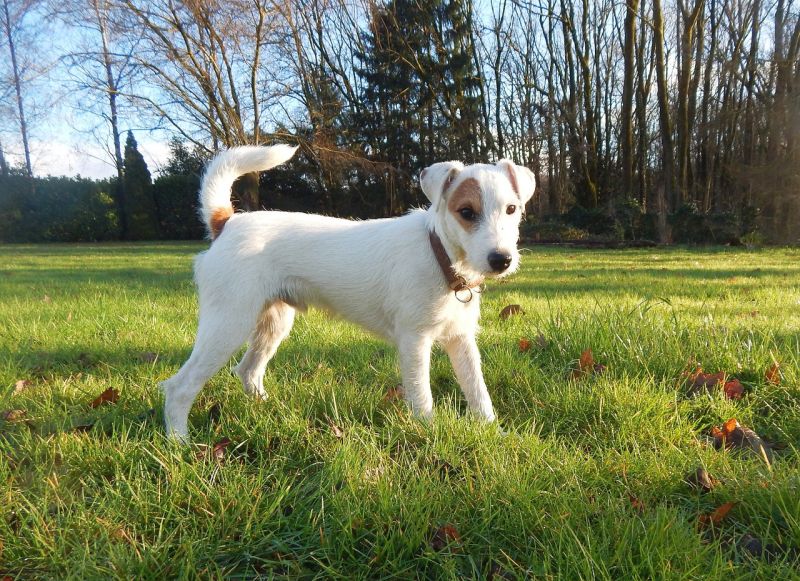
Next on our quickfire white dog breeds of the UK tour, we’re heading to the south of England where the Parson Russell terrier came from!
Parson Russell terriers, while very similar to Jack Russell terriers, are slightly taller and heavier, but they’re also very similar in temperament. Adorable small white doggos, who’re most commonly seen with black or brown patches of fur, these confident canines have a life expectancy of around 13 to 15 years.
Parson Russell terriers were bred as fox hounds and were successful in their roles due to their small, athletic frames and high energy levels. As an owner, you’ll need to be willing to accommodate their exercise needs by living an active lifestyle and bringing them on all the adventures. With an instinctively strong prey drive, recall training is going to be a big part of your guys’ routine!
17. Sealyham Terrier
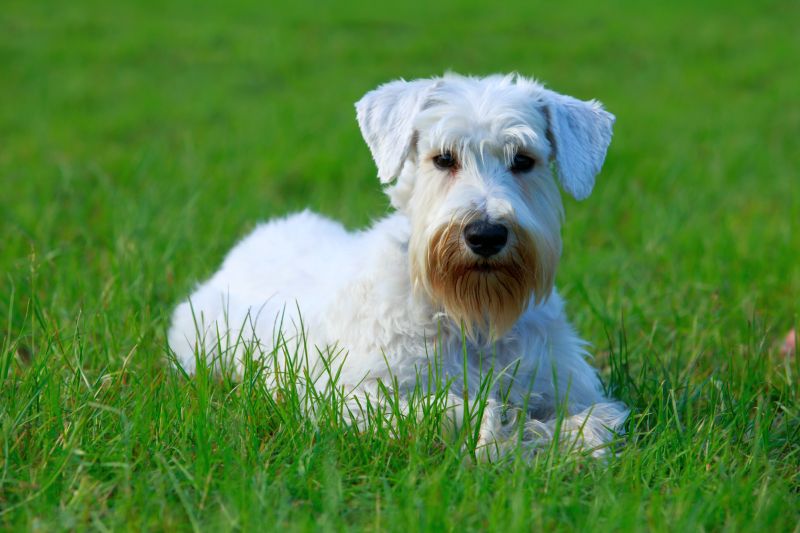
And last but not least, the Sealyham terrier. Bred by an army captain on the Sealyham Estate in Wales, they are a terrier in spirit, but with a much gentler heart. Sealyhams have magnificent beards and white fur that falls around their body in a long, rectangular shape.
This is a lesser known breed to many, but not to the British royals. The likes of the Queen Mother and Princess Margaret were particularly fond of their Sealyhams, as were Hollywood royalty such as Cary Grant and Humphrey Bogart. We’re guessing they were big fans of the breed’s kindness, loyalty and eagerness to please and impress their owners.
Sealys’ coats are weather-resistant and don’t shed much, but will require brushing multiple times a week to prevent matting. You can keep their coats short to avoid so much grooming, but if you want the “show” coat, you may want to have your Sealyham professionally groomed.
With a working background, Sealys are very energetic and will need a lot of exercise to keep them happy. Without it, they can get frustrated and cause mischief around the house. Owners report that Sealys can guard their food, so training should focus around avoiding this.
Considerations for Small White Dog Breeds
Whether you already own a small white dog, or you are looking to adopt or buy one, there are a few things you should consider.
All breeds have their own training, exercise, and grooming requirements, and small white dogs are no different. Here are a few things to bear in mind:
- Some will experience skeletal issues. Small white dog breeds (especially toy breeds) are known to suffer with a number of skeletal issues, such as luxating patellas or hip dysplasia. The risk can be reduced through responsible breeding, and the Orthopedic Foundation for Animals (a public database for health screening information), is a great resource for ensuring your prospective breeder has conducted tests in line with the AKC.
- They may get tear stains. Tear stains can occur in all breeds but are more noticeable in white dog breeds. Providing they are not a symptom of an underlying health issue, tear stains are very manageable to treat and prevent.
- Many require elaborate grooming. Almost all of the breeds mentioned in this article require daily grooming and a visit to a professional groomer every four to six weeks. Dental hygiene is especially important in toy breeds and their teeth should be cleaned daily in addition to routine dental appointments at the vet.
- Some small dogs have trouble with house-training. Though nobody knows exactly why, smaller breeds are often more difficult to housetrain. Some believe this is due to their smaller bladders, while others believe it is actually tougher for owners to train small breeds. For example, the messes pint-sized pups make are smaller and more difficult to find, and the physical cues are more difficult to see in a smaller dog.
- Some may shake or tremble. Sometimes small dogs may shake or tremble. While usually harmless, it can be cause for concern in some cases. Just be sure to speak to your veterinarian about it if you notice Fido trembling frequently.
- Some small breeds have special nutritional requirements. Little waggers have tiny stomachs and high caloric demands, and many are prone to dental issues. So, be sure to look for one of the best dog foods for small breeds to get your pooch started on the right paw.
***
That was quite the adventure! There’s a small white dog breed for everyone, from all corners of the globe! Are there any on this list that are current members of your family? If so, please share your experience with our community in the comments.
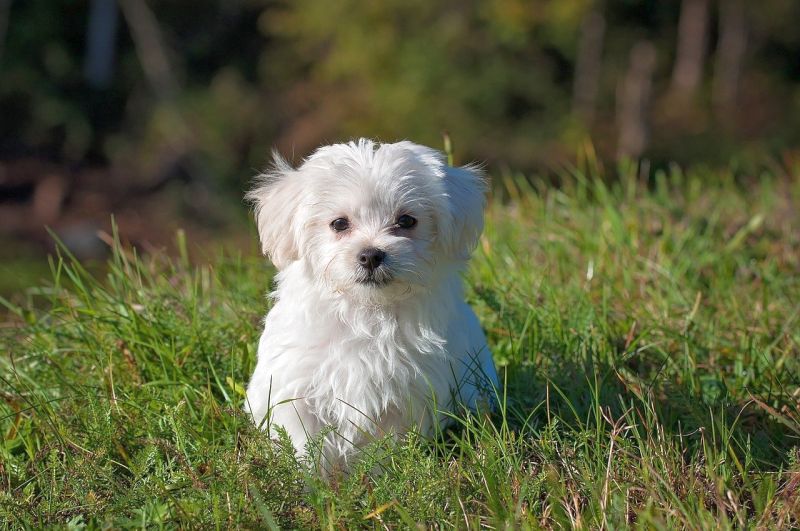




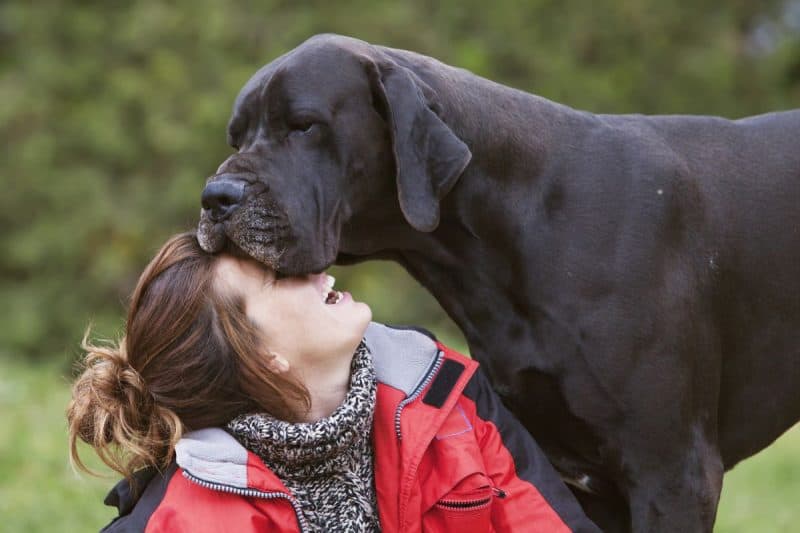
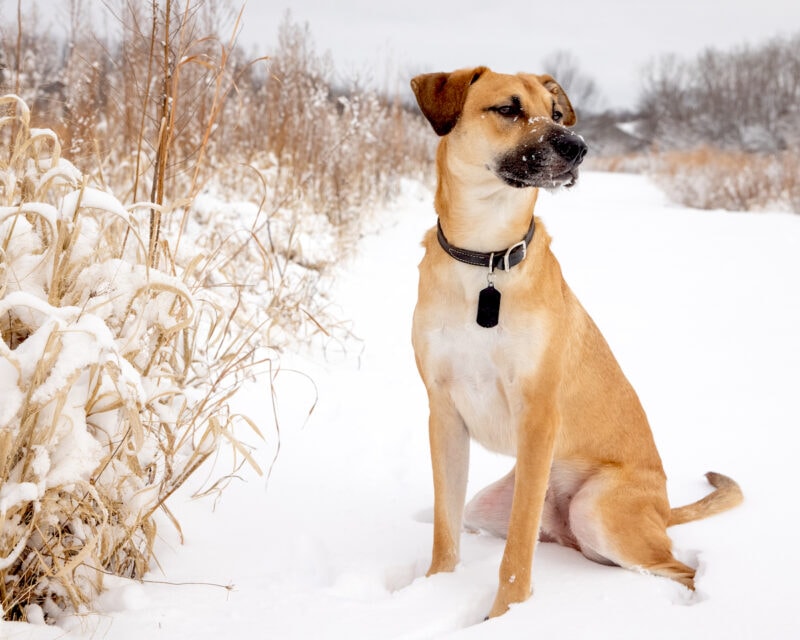
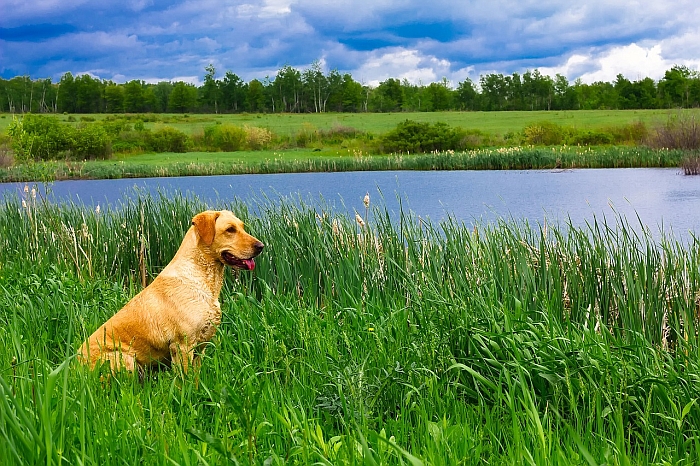
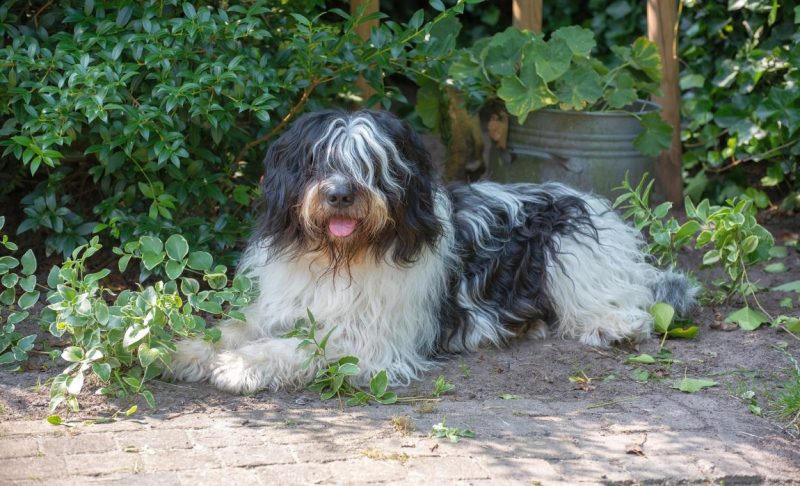
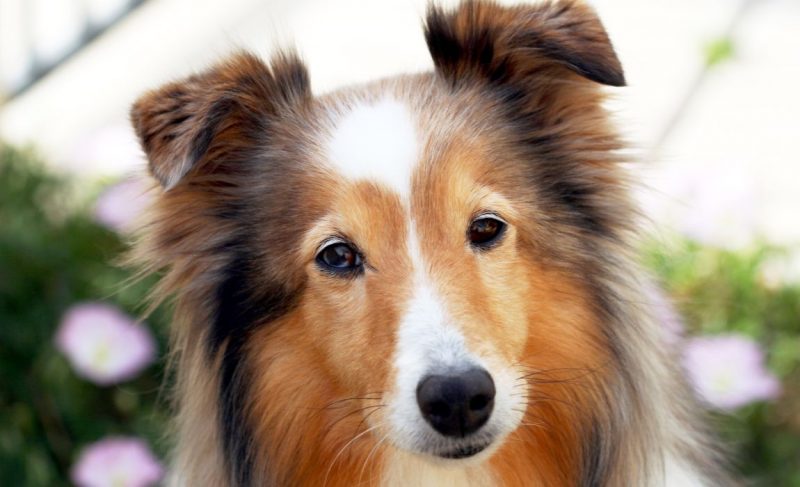
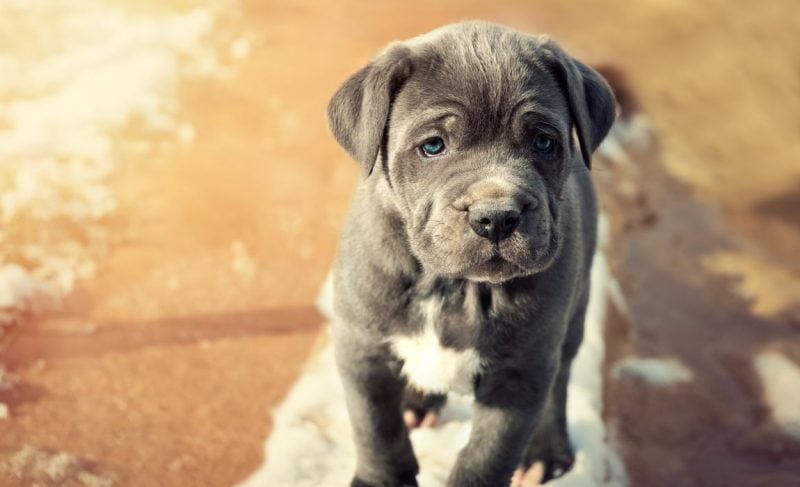

Leave a Comment